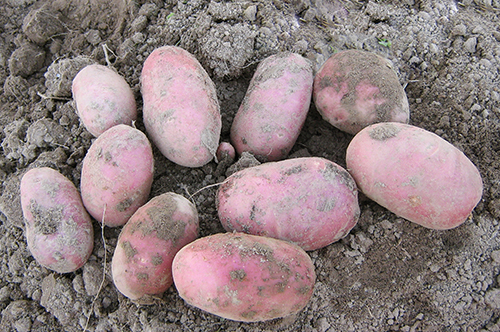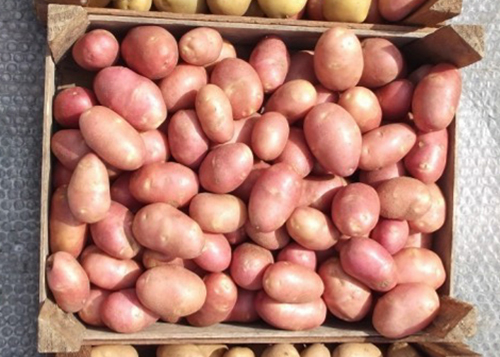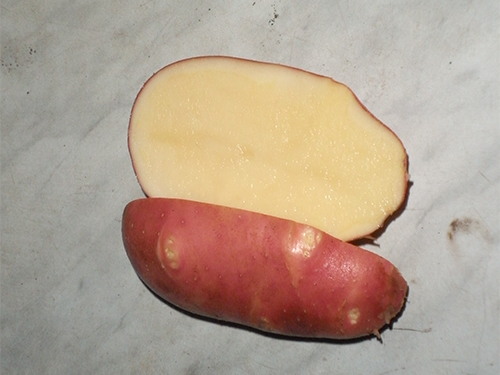Potato variety Red Scarlet
Red Scarlet is a Dutch table potato variety widely distributed in the Central and Southern regions of Russia. It has a high yield potential, providing about 600 centners per hectare, and excellent consumer qualities. One of the best red-skinned varieties, included in the State Register of the Russian Federation.

Consider the external features of this variety, its main characteristics, susceptibility to diseases and planting features.
Description of the Red Scarlet variety
Due to its external characteristics, Red Scarlet can be easily distinguished from the rest. Potato tubers are oblong oval in shape with smooth red skin and tender yellow flesh. Form index in the range of 1.50 - 1.69. Tubers are formed in large numbers, almost simultaneously, and their keeping quality is about 98%. The surface of the tubers is slightly flaky. There are shallow eyes on it, the depth of which is approximately 1 - 1.3 millimeters. The size of the tuber is most often medium to large, and the weight is approximately 80 - 130 grams.
The bush is usually low, semi-erect. The formation of a good and dense tops occurs quickly enough. The stems are usually of medium thickness with a medium anthocyanin coloration. The leaves are dark green in color, medium in size and slightly wavy at the edge. Inflorescences are light lilac or red-violet. The light sprout has an ovoid shape and a medium-low base of red-violet color.

Characteristics
This variety is characterized by an earlier ripening, the growing season of potatoes is approximately 75 days. Potatoes are drought tolerant. The rest period is medium-long. Stores well for a long time, remaining unchanged in appearance. It is characterized by high marketability. The starch content is 11-15%, dry matter - 18.6%. The potatoes are weak, the excellent appearance of the tubers does not change after boiling. During cutting, the potatoes do not acquire the dark color characteristic of other varieties. Resistant to various types of mechanical damage and secondary germination.
Red Scarlet is grown both for the industrial production of french fries and chips and for grocery stores and markets.
Diseases
This potato variety has good immunity to the most famous viral diseases and withstands the onslaught of the golden potato nematode, PVYn virus and cancer, which is important and is another undoubted advantage of this variety. It is weakly resistant to Alternaria and common scab. It has a high sensitivity to late blight of foliage, but at the same time good resistance to late blight of tubers.

In high temperatures, in order to avoid darkening of the pulp, on light soils, it is recommended to form larger ridges, regularly maintain moisture in the soil and add additional doses of Calcium (mainly during planting). It is recommended to apply the same amount of nitrogen as for other early varieties. Red Scarlet is also responsive to manganese and magnesium additions.
Planting Red Scarlet Potatoes
Planting depth of potatoes is average. The planting material should be germinated until the shoots appear (2 - 5 mm), which do not break off during planting. Row spacing during planting should be about 60 - 75 cm. The first shoots appear two to three weeks after planting. The seeds of this potato are of high value due to their 50-day yield.
In order to get a productive crop, it is necessary to create a loose soil in the places where the tubers are located, so that moisture and air can freely reach them.This will contribute to the formation of a good root system, as well as the active formation of tops. Before planting, you should also check the planting material for damage or rot.
This variety is planted, alternating with legumes, and the tops are removed about 7 to 10 days before harvesting. Cleaning itself takes place in late August or early September. This is necessary in order to obtain mature and healthy potatoes with a strengthened skin, to reduce mechanical damage to tubers and to increase their keeping quality.
This potato variety is extremely popular in food service establishments due to its excellent taste. Red Scarlet contains many minerals, vitamins and amino acids, and retains all its beneficial qualities for a long time.
Thus, it is worth noting that the harvested potatoes of this variety will be equally useful both in September, during the harvest period, and in February - March, when the human body needs additional portions of nutrients. An important advantage of this variety is its low cost in comparison with other varieties of potatoes.









Great potatoes! We have been growing it for three years and are very happy with the harvest during this time! Our black soil and tubers are very large, much larger than average. No trifles to be discarded. During the winter, rarely when 1 - 2 potatoes will rot out of 70 buckets (we keep that much for the winter and for planting). Excellent taste for mashed potatoes, for soup, and for baking. In the spring does not sprout in the basement like others. But the Colorado beetle loves her so much (((Apparently he also liked it. Otherwise, everything is as in the description above. In our Voronezh Territory, this variety has taken root perfectly. I advise.
Everything would be fine, but last year it was a rainy summer. And it was this variety that had a lot of potatoes with a "hollow" (a hole inside).
The variety is declared by breeders as good and satisfactory in taste. It's great for selling, storing, chips and frying, to a lesser extent. All the counters are littered with it, and that says a lot.
I agree with Galina. Experimenting with varieties, but this one is literally a lifesaver. In any weather you will always have potatoes. And it is stored better than many others. In cooking, it is versatile, and the mashed potatoes are delicious, and they are good in their uniforms, and they do not boil in the soup.
Hurrah!
Can be bought online for 3 kg landing. I live in Iceland.
Selling 40 varieties of potatoes from my collection
This year I did not plant this variety. The yield is low. Yes, 2-3 large potatoes. By the beginning of August, the tops are already drying out, while other varieties are green. Short growth periods mean a low yield. Maybe I did something wrong. Drought tolerance is also questionable. Stored normally like my other varieties. The taste is not bad, but nothing outstanding.